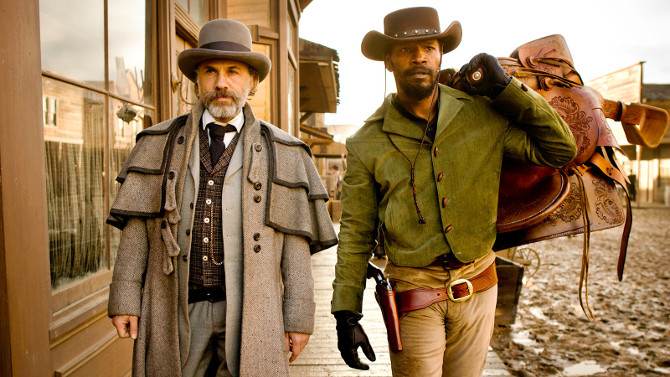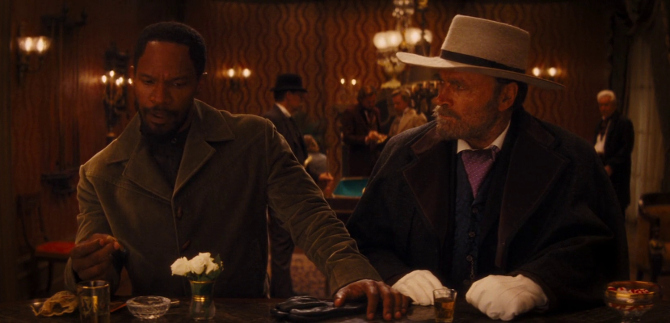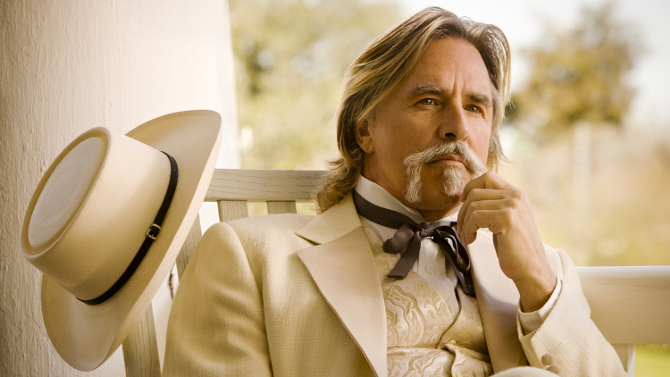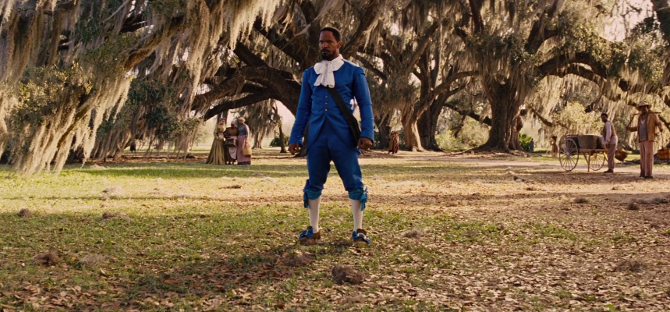Reworking the spaghetti western one strand at a time, Quentin Tarantino updates the Italian sub-genre for the modern age, 2012’s Django Unchained, an epic tale of lost love and hopeful reunion. . . and, of course, bloody revenge.
Following a charmingly charismatic and cunning bounty hunter. . . who used to be a dentist, Dr. King Schultz (Christoph Waltz) is a master planner who has a flair for the dramatic. Tracking down a slave named Django (Jamie Foxx), he needs the man to help him finger his next set of criminals (setting him free for the task). Without giving away what happens on the first bounty Django joins him on, it is the quintessential mix of Tarantino humour combined with bloody violence – a scene of utter perfection.
As Schultz learns of Django’s usefulness, they become partners, making a deal: after a winter’s worth of bounty hunting, the pair will make their way to find the former slave’s wife, Broomhilda von Shaft (Kerry Washington) – a German speaking slave who was sold to another master.
Eventually they learn that said master is Calvin Candie (Leonardo DiCaprio), a major slaveholder who runs what he calls ‘Mandingo Fights’ – gruesome battles to the death between slaves. Also the owner of the infamous Candyland estate, the man is a beguiling presence. . . with more than enough enchanting charm to fill a tall glass of sweet iced tea, there is more than a bite of vitriolic savagery hidden somewhere within – and, I must say, it is never far from the surface.
Devising a plan to retrieve the woman, Schultz pretends to be a man looking to buy one of Candie’s most impressive slave fighters, Django, his supposed advisor. Meeting the man at a gentlemen’s club they know he frequents, for fans of the original Italian fare, this will be a very special scene. New Django meets old, with Franco Nero playing Amerigo Vessepi, an Italian slaver. A cheeky, wink wink/nudge nudge piece of dialogue, I put it here in its complete form for your enjoyment:
Amerigo Vessepi: What’s your name?
Django: Django.
Amerigo Vessepi: Can you spell it?
Django: D-J-A-N-G-O. The D is silent.
Amerigo Vessepi: I know.
Piquing the wealthy man’s interest with their over-the-top offer, he invites the pair back to Candyland. . . no amusement park if you aren’t white (or don’t fall in line with the maniacal landowner). Managed by an elderly curmudgeon, Stephen (Samuel L. Jackson), he is sharp as a fox and nearly as cruel as his master. A daunting task, will Schultz and Django’s clever if dangerous plan come to fruition? Or, will their attempted rescue of Hilda (from this mansion of horrors) fail in a most bloody way?
A cinephile nonpareil, Tarantino pulls some of the most fascinating visual elements from the spaghetti western – dramatic zooms, smoldering visual closeups, extreme wide shows to show the striking landscapes, shoot from the hip bloody violence, and other such techniques, while never missing a chance to add his own flair along the way – visually and by way of the written word. Known for his random, non plot directed conversations that pop up in his films, one such moment finds a group of racist white folk (who have been slighted by the dentist and former slave) wearing bags over their heads – an almost KKK form of protection used before storming the pair in a violent form of revenge. . . of course, the bags don’t work very well, leading to a comedic argument that is so very Tarantino. Another example of his cheeky touch is that he imagined Django and Hilda as being the great-great-great grandparents of film icon Shaft (why Hilda’s last name is Shaft) – another nice little touch. A more dubious statistic, Django holds the record for most uses of the “n” word – one hundred and sixteen to be exact. And, perhaps my favourite piece of comedy is the fact that Schultz, being a German, speaks better English (and has a more vast vocabulary) than any of the Americans he encounters on his journeys.
Likewise, the story almost has a Shakespearian quality. For you have Candie – a man whose teeth are literally rotting due to his love of sweets – something seen throughout the film. . . yet, figuratively, it symbolizes that the man is rotten to the core. Who better to deal with such a situation than a dentist/bounty hunter (trained to deal with both rotten teeth and human beings) – a clever storyline so subtle it was likely missed by some.
Another fabulous tale from the set. . . in one of Candie’s most violent outbursts, a sequence in which DiCaprio slams his hand on the table, he actually cut his palm on a stemmed glass. Bleeding, he continued on, nailing the rest of the dialogue, Tarantino so pleased with the final result that he used it.
Full disclosure here: this little rant doesn’t have anything to do with the quality of this movie. It has to do with the Academy Awards. Django won two Oscars, Best Supporting Actor for Christoph Waltz and Best Original Screenplay for Quentin Tarantino. . . and though they are both deserved, it makes me wonder just how they distinguish these categories. Waltz is basically the lead for most of the film. . . making it difficult for those who have ten or fifteen minutes of screen time to compete with someone who can be seen onscreen for so much of the film’s runtime (it is, to this date, the longest ever to win this award). As for Tarantino, he based the story loosely off of the Django spaghetti western films (as well as other spaghetti westerns). . . so, really, how can this be called an original screenplay? Each year, there are examples such as this, but perhaps none so blatant as these two. Some more stringent guidelines should be put into place to make sure these loopholes are not exploited for easier victories.
Now, to get back on track, like his recently released Once Upon a Time … In Hollywood, Django is a like a fun game of Where’s Waldo?. . . with so very many interesting roles and cameos. Look for the always entertaining Walton Goggins, Miami Vice’s Don Johnson, The Dukes of Hazzard’s Tom Wopat, father and daughter duo Russ and Amber Tamblyn, icon Bruce Dern, character actor M.C. Gainey, Tarantino regular Zoë Bell, legendary makeup guru Tom Savini, as well as Jonah Hill, Robert Carradine, and a cameo from Tarantino himself (porting a rather amusing Australian accent).
And, much like the varied faces, the soundtrack is its own treat. Ranging from classical tunes such as Beethoven’s Für Elise and Verdi’s Dies Arae (Requiem), to more modern music such as the Black Opium Remix of Johnny Cash’s Ain’t Not Grave and John Legend’s Who Did That To You, the entire piece is centred on more traditional western movie music. Expect to hear recycled Ennio Morricone scores, as well a number of other varied compositions, including the English version of the Django Theme Song, by Luis Bacalov and Rocky Roberts.
An over the top film that has a little bit of everything, Django Unchained even has Jamie Foxx dressed as Little Lord Fauntleroy – really, how can you go wrong. Featuring all you would expect from Tarantino, it is a bloodstained epic western with many touches of comedy, romance, and adventure. Just as proficient at capturing the beautiful landscape of the American west (California, Wyoming, and, quite a bit more east, Louisiana), it is in stark juxtaposition to Tarantino’s violent outbursts. So, don’t ride off into the sunset before seeing this motion picture, it’s dynamite!





